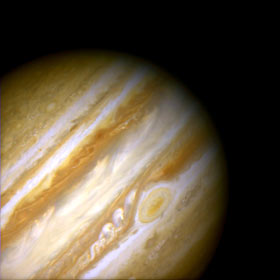
Save this image free of charge
in 800 pixels for layout use
(right click, Save as...)
|
|
Ref : S02590
Theme :
Moons and planets (174 images)
Title : An Ancient Storm in the Jovian Atmosphere
Caption :
When 17th-century astronomers first turned their telescopes to Jupiter, they noted a conspicuous reddish spot on the giant planet. This Great Red Spot is still present in Jupiter's atmosphere, more than 300 years later. It is now known that it is a vast storm, spinning like a cyclone. Unlike a low-pressure hurricane in the Caribbean Sea, however, the Red Spot rotates in a counterclockwise direction in the southern hemisphere, showing that it is a high-pressure system. Winds inside this Jovian storm reach speeds of about 270 mph. The Red Spot is the largest known storm in the Solar System. With a diameter of 15,400 miles, it is almost twice the size of the entire Earth and one-sixth the diameter of Jupiter itself. The long lifetime of the Red Spot may be due to the fact that Jupiter is mainly a gaseous planet. It possibly has liquid layers, but lacks a solid surface, which would dissipate the storm's energy, much as happens when a hurricane makes landfall on the Earth. However, the Red Spot does change its shape, size, and color. Such changes are demonstrated in high-resolution Wide Field and Planetary Cameras 1 & 2 images of Jupiter obtained by NASA's Hubble Space Telescope, and presented here by the Hubble Heritage Project team. The Hubble images were originally collected by Amy Simon (Cornell U.), Reta Beebe (NMSU), Heidi Hammel (Space Science Institute, MIT), and their collaborators, and have been prepared for presentation by the Hubble Heritage Team.
|
|

